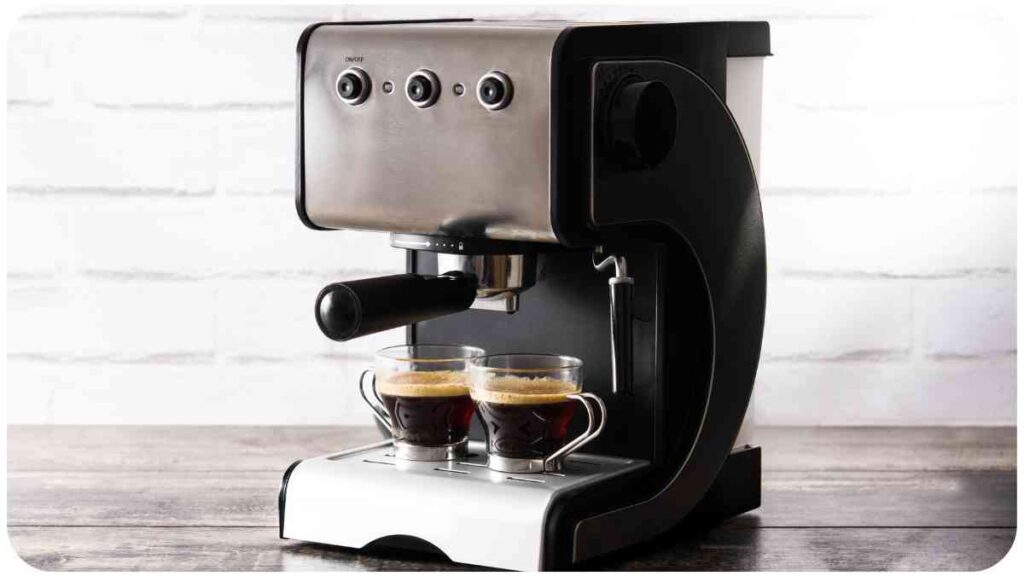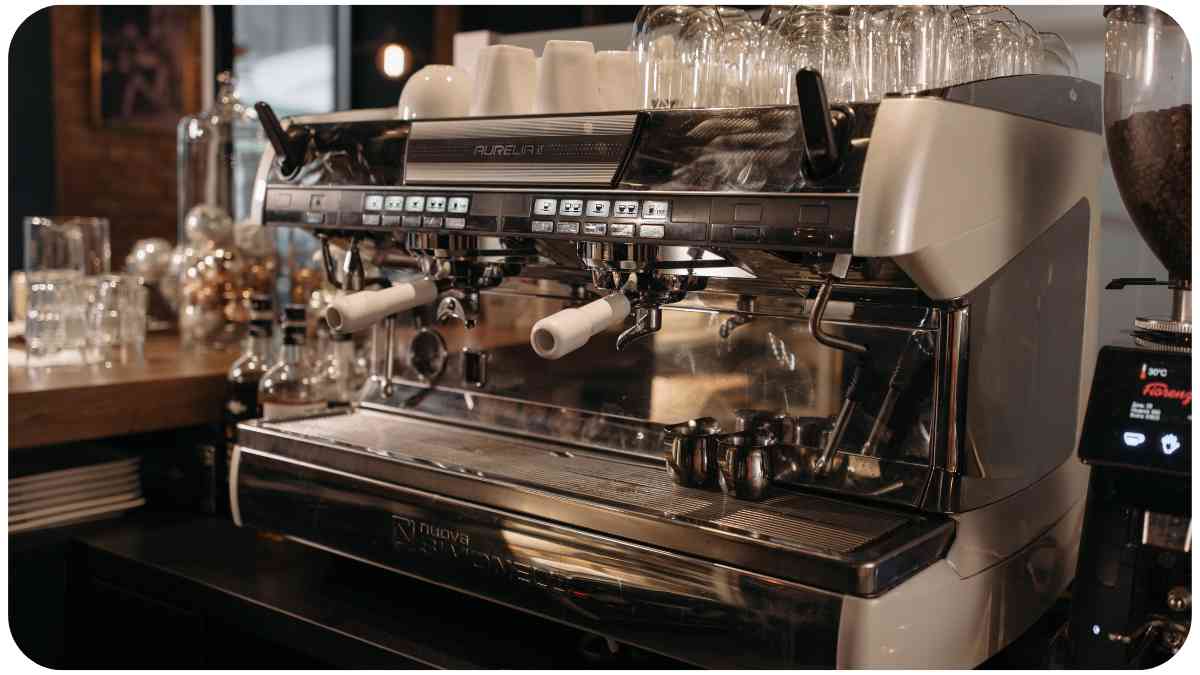Welcome, coffee enthusiasts and proud De’Longhi espresso machine owners, to a guide that’s tailor-made to help you navigate the common challenges that might arise during your coffee-making journey. As a seasoned coffee lover and espresso machine aficionado, I understand the joys and frustrations that come with brewing your perfect cup.
In this article, we’ll troubleshoot the typical issues that might be affecting your De’Longhi machine and offer practical solutions that will have you enjoying velvety shots of espresso in no time.
| Takeaways |
|---|
| Regularly clean and maintain your De’Longhi espresso machine for optimal performance. |
| Address uneven extraction by ensuring even tamping and proper coffee puck distribution. |
| Troubleshoot slow drips or no espresso by adjusting grind size, checking water pressure, and calibration. |
| Combat bitterness by adjusting grind size and maintaining proper water temperature. |
| Master milk frothing with proper steam pressure, technique, and consistency. |
| Address leaks by checking connections, seals, and setup. |
| Maintain and replace parts like gaskets, grouphead screens, and water filters as needed. |
| Seek professional help for persistent issues or out-of-warranty machines. |
| Use authorized service centers for repairs and maintenance. |
| Keep in mind FAQs regarding machine noise, cleaning frequency, water quality, and grinder issues. |
Understanding Your De’Longhi Espresso Machine

Before we dive into troubleshooting, it’s essential to grasp the inner workings of your De’Longhi espresso machine. These sophisticated devices combine technology and craftsmanship to deliver your daily dose of caffeine. Take a moment to familiarize yourself with the main components: the portafilter, water reservoir, steam wand, and grinder (if applicable).
Unveiling the hidden realities, explore the dark side of the coffee industry, revealing the intricate challenges and ethical dilemmas faced by producers and consumers alike.
Table: Components of a De’Longhi Espresso Machine
| Component | Function |
| Portafilter | Holds the coffee grounds and attaches to the machine for extraction |
| Water Reservoir | Stores water for brewing and steaming |
| Steam Wand | Emits steam for frothing milk |
| Grinder | Grinds coffee beans into grounds, if your model includes a built-in grinder |
With a clear understanding of these components, you’re ready to diagnose and address any issues that may arise.
Basic Maintenance for Optimal Performance
To keep your De’Longhi machine running smoothly and producing exceptional espresso, regular maintenance is key. Here are two fundamental maintenance tasks that you should incorporate into your routine:
Cleaning the Portafilter
The portafilter is where the magic happens—the coffee grounds are tamped and brewed here. However, residues from previous brews can accumulate, affecting the taste and quality of your espresso. Regular cleaning is a must.
Table: Steps to Clean the Portafilter
| Step | Action |
| 1 | Remove the portafilter from the machine. |
| 2 | Knock out the used coffee grounds into a bin. |
| 3 | Rinse the portafilter basket with warm water. |
| 4 | Use a brush to clean the grouphead gasket. |
| 5 | Wipe the portafilter and basket with a cloth. |
| 6 | Reassemble the portafilter and return it to the machine. |
Descaling the Machine
Mineral deposits can build up in your machine over time, affecting water flow and temperature. Descaling is crucial to maintaining peak performance.
Dive into the world of responsible cultivation as you navigate sustainable coffee farming. This guide elucidates the practices that contribute to a more ethical and environmentally friendly coffee production.
Table: Steps to Descale Your De’Longhi Espresso Machine
| Step | Action |
| 1 | Empty the water reservoir and remove the water filter. |
| 2 | Mix a descaling solution with water as per the instructions. |
| 3 | Fill the water reservoir with the descaling solution. |
| 4 | Turn on the machine and start the descaling process. |
| 5 | Run the solution through the machine’s brewing cycle. |
| 6 | Rinse the water reservoir and fill it with clean water. |
| 7 | Run clean water through the machine to rinse thoroughly. |
By incorporating these maintenance tasks into your routine, you’re setting the stage for a consistently satisfying espresso experience.
Espresso Extraction Problems and Solutions
A properly extracted shot of espresso is the cornerstone of any great coffee. However, issues can arise that compromise the quality of your brew. Let’s explore some common extraction problems and their solutions.
Uneven Extraction
Is your espresso pouring unevenly, with one side darker than the other? This can be a sign of uneven tamping or an improperly distributed coffee puck.
Table: Solutions for Uneven Espresso Extraction
| Issue | Solution |
| Uneven Tamping | Ensure even pressure when tamping the coffee grounds. |
| Uneven Puck | Use a distribution tool to evenly distribute coffee grounds before tamping. |
Slow Drip or No Espresso
If your espresso is dripping out slowly or not at all, the issue might lie in the grind size, water pressure, or machine calibration.
For every coffee enthusiast, understanding the importance of sustainability is paramount. Learn how your love for coffee can align with ethical choices, fostering a positive impact on the industry.
Table: Solutions for Slow Drip or No Espresso
| Issue | Solution |
| Fine Grind | Adjust the grinder to a coarser setting. |
| Low Water Pressure | Check the water reservoir and pump for clogs. |
| Machine Calibration | Recalibrate the machine based on the user manual. |
Bitter Taste
A bitter taste can ruin even the finest espresso. It’s often the result of over-extraction, where the water spends too much time in contact with the coffee grounds.
Table: Solutions for Bitter-Tasting Espresso
| Issue | Solution |
| Over-Extraction | Adjust the grind size to make it coarser and shorten the extraction time. |
| Water Temperature | Ensure the water temperature is within the recommended range for espresso extraction. |
By addressing these extraction issues head-on, you’ll be well on your way to brewing consistently delicious espresso shots.
Milk Frothing Issues

If you’re a fan of lattes and cappuccinos, mastering the art of milk frothing is essential. However, even the best of us can encounter issues in this process.
Weak Steam Pressure
Weak steam pressure can lead to lackluster milk froth. This might be due to a clogged steam wand or insufficient time for the machine to heat up.
Transform your coffee haven into an environmentally conscious space by implementing eco-friendly practices. Discover practical steps to reduce your coffee shop’s ecological footprint while still delighting customers.
Table: Solutions for Weak Steam Pressure
| Issue | Solution |
| Clogged Steam Wand | Clean the steam wand using a pin or paperclip, following the manufacturer’s instructions. |
| Insufficient Heat | Allow the machine ample time to heat up before frothing. |
Inconsistent Froth
Is your frothed milk varying in texture and consistency? This could be due to improper technique or irregular steam pressure.
Table: Solutions for Inconsistent Milk Froth
| Issue | Solution |
| Incorrect Technique | Position the steam wand tip just below the milk’s surface and angle it for optimal aeration. |
| Variable Steam Pressure | Ensure steady steam pressure by opening the steam valve fully and maintaining consistency. |
Mastering milk frothing takes practice, but with these tips, you’ll be creating creamy microfoam in no time.
Machine Leakage and Drips
Nothing dampens the coffee experience like finding unexpected puddles or drips beneath your espresso machine. Let’s address the common culprits behind these leaks.
Elevate your coffee experience by supporting the best sustainable coffee brands. Explore how these brands prioritize ethical practices, contributing to a more sustainable and responsible coffee industry.
Water Leakage
Water leakage can stem from loose connections, damaged parts, or improper setup.
Table: Solutions for Water Leakage
| Issue | Solution |
| Loose Connections | Ensure all water reservoir and hose connections are secure. |
| Damaged Seals | Inspect and replace any damaged seals, such as the grouphead gasket. |
| Improper Setup | Ensure the machine is positioned on a level surface to prevent water from pooling. |
Coffee Grounds Leakage
Finding coffee grounds outside of the portafilter can be frustrating. This might occur due to incorrect tamping or a damaged portafilter basket.
Table: Solutions for Coffee Grounds Leakage
| Issue | Solution |
| Incorrect Tamping | Practice consistent tamping pressure to prevent coffee grounds from escaping the basket. |
| Damaged Basket | If the portafilter basket is damaged, replace it to ensure a proper seal during extraction. |
Machine Not Turning On
If your machine refuses to power up, there could be a range of issues at play.
Table: Solutions for Machine Not Turning On
| Issue | Solution |
| Power Supply Issue | Check if the power cord is properly connected and the outlet is working. |
| Safety Features | Ensure the machine’s safety features, such as the drip tray or water reservoir, are in place. |
| Electrical Problem | If all else fails, consult the user manual and consider professional repair. |
Grinder Problems
For those who prefer freshly ground beans, a malfunctioning grinder can be a real setback. Let’s troubleshoot some common grinder issues.
Uneven Grinding
Inconsistent grind size can lead to uneven extraction and a disappointing cup.
Table: Solutions for Uneven Grinding
| Issue | Solution |
| Dull Burrs | Sharpen or replace the grinder burrs as per the manufacturer’s guidelines. |
| Incorrect Settings | Adjust the grinder settings to achieve the desired grind size for your brewing method. |
Grinder Jamming
A jammed grinder can halt your coffee-making endeavors. This might be due to oily beans or foreign objects.
Table: Solutions for Grinder Jamming
| Issue | Solution |
| Oily Beans | Use dry beans and avoid oily or flavored ones, which can clog the grinder. |
| Foreign Objects | Clear the grinder of any foreign objects, and ensure the hopper is properly closed. |
Error Messages and Troubleshooting
Modern espresso machines often come equipped with error codes to help diagnose issues.
Table: Common Error Codes and Solutions
| Error Code | Solution |
| E01 – E09 | These codes often indicate sensor or temperature-related issues. Refer to the user manual for specific troubleshooting steps. |
| E10 | Insufficient water in the reservoir. Fill the reservoir and restart the machine. |
| E11 | The water reservoir is empty. Refill it and restart the machine. |
Replacing Parts and Maintenance
Over time, certain parts of your espresso machine may wear out and require replacement. Let’s discuss a few key components and how to maintain them.
Seals and Gaskets
Seals and gaskets ensure a proper seal between different parts of the machine, preventing leaks and maintaining pressure.
Table: Maintenance and Replacement of Seals and Gaskets
| Component | Maintenance | Replacement |
| Grouphead Gasket | Regularly clean and lubricate with food-safe grease. | Replace every 6-12 months, depending on usage. |
Grouphead Screen
The grouphead screen filters the water as it flows through the coffee grounds. It can become clogged over time.
Table: Cleaning and Replacing the Grouphead Screen
| Task | Frequency |
| Cleaning | After every use or at least once a week. |
| Replacement | Every 6-12 months, based on usage. |
Water Filter
If your machine has a water filter, it needs to be replaced periodically to maintain water quality.
Table: Replacing the Water Filter
| Task | Frequency |
| Replacement | Follow the manufacturer’s guidelines. |
By regularly replacing these parts and following maintenance protocols, you can extend the life of your espresso machine and ensure consistently excellent results.
Professional Maintenance and Repair
While many issues can be resolved with DIY troubleshooting, there are times when professional help is necessary.
When to Seek Professional Help
If you encounter persistent issues, unusual noises, or if your machine is out of warranty, it’s wise to consult a professional technician.
Table: Signs You Need Professional Help
| Issue | Action |
| Persistent Problems | If issues persist despite your efforts, it’s time to consult a professional. |
| Out of Warranty | If your machine is no longer under warranty, professional help is recommended. |
Finding Authorized Service Centers
To ensure your machine is in capable hands, seek out authorized service centers or technicians.
Table: Steps to Find Authorized Service Centers
| Step | Action |
| 1 | Visit the De’Longhi website and use their service center locator tool. |
| 2 | Contact the center and describe the issue to schedule a repair or maintenance appointment. |
Frequently Asked Questions (FAQs)
Let’s address some common questions that espresso machine users often have.
Table: FAQs and Answers
| Question | Answer |
| Is it normal for the machine to produce noise during operation? | Yes, some noise is normal as water is heated and pressurized. |
| How often should I clean my machine? | Clean the machine’s parts that come into contact with coffee daily, and perform a deep clean every 1-2 weeks. |
| Can I use tap water in my De’Longhi machine? | It’s recommended to use filtered or bottled water to prevent mineral buildup. |
Conclusion
Congratulations! You’ve gained a deeper understanding of troubleshooting common issues with De’Longhi espresso machines. By following the steps outlined in this guide, you’re equipped to diagnose and address a wide range of problems, ensuring your coffee-making journey remains smooth and enjoyable.
Remember, with a bit of practice and a dash of patience, you’ll be sipping on barista-quality espresso from your De’Longhi machine in no time.
Feel free to bookmark this guide for future reference, and never hesitate to seek professional assistance when needed. Happy brewing!
Further Reading
For more in-depth insights and guidance on troubleshooting your De’Longhi espresso machine, consider exploring the following resources:
- Roasty Coffee: De’Longhi Espresso Machine Troubleshooting: This comprehensive guide delves into common issues and offers practical solutions, ensuring your coffee journey remains frustration-free.
- Fluent in Coffee: De’Longhi Espresso Machine Troubleshooting: Discover expert tips and step-by-step instructions to troubleshoot your De’Longhi machine and achieve consistent espresso perfection.
- Best Espresso Coffee: De’Longhi Espresso Machine Troubleshooting: This resource provides valuable insights and recommendations for addressing espresso machine issues, helping you become a true coffee connoisseur.
FAQs
Is it normal for my De’Longhi espresso machine to produce noise during operation?
Yes, some noise is normal as the machine heats up water and builds pressure to create your espresso. However, excessive or sudden noises might indicate a problem that requires attention.
How often should I clean my De’Longhi espresso machine?
Cleaning the parts that come into contact with coffee, like the portafilter and steam wand, should be done daily. For a deeper clean, perform thorough maintenance every 1-2 weeks to prevent buildup and ensure optimal performance.
Can I use tap water in my De’Longhi machine?
While you can use tap water, it’s advisable to use filtered or bottled water to prevent mineral buildup that can affect the taste and longevity of your machine.
Why is my espresso extraction uneven?
Uneven extraction can be caused by factors like uneven tamping or an improperly distributed coffee puck. Ensuring even pressure during tamping and using a distribution tool can help address this issue.
How do I troubleshoot milk frothing issues?
If you’re experiencing weak steam pressure or inconsistent froth, ensure your steam wand is clean and properly positioned. For weak steam pressure, also allow the machine sufficient time to heat up before frothing.

Hi, I’m Hellen James, founder of Unified Coffees. I created the platform to fill the gap in coffee blogging by providing tips on brewing coffee, rather than just focusing on beans and grinders.


